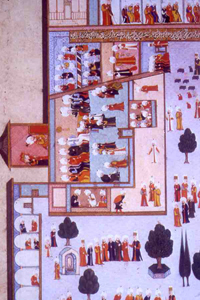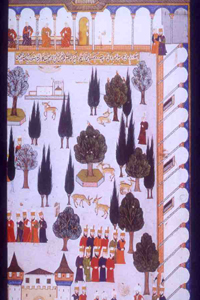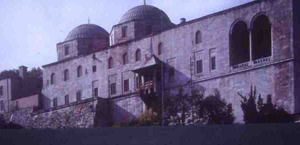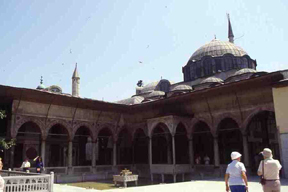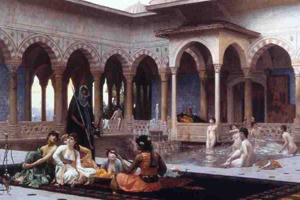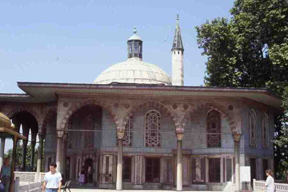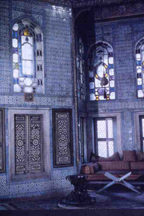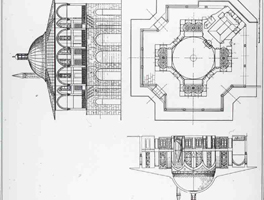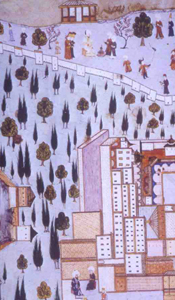AGA KHAN PROGRAM FOR ISLAMIC ARCHITECTURE
Course 4.611/4.613:
12- The Creation of an Ottoman Palatial Complex: (Click on images to enlarge)
The Topkapi Saray (the Gun Gate Palace) in Istanbul was the Ottoman sultans' residence and the seat of government for almost four centuries (1460-1850). It is composed of a series of buildings surrounding a number of interconnected courts on the top of a hill that overlooks the Golden Horn and the Marmara Sea. The first phase was completed in 1464-65 under Fatih Mehmet II (the Conqueror) who occupied Constantinople in 1453, changed its name to Istanbul, and prepared it to become the Ottoman capital.
Plan of Istanbul from the Matrakci Nasuh manuscript from the early 16th century showing the location of the Topkapi Saray at the upper right hand tip |
Topkapi Saray; plan |
Çinili Kiosk (The Tiled Pavilion) (1473):
The earliest remaining pavilion from the first building of Fatih, it shows the Timurid influence on the early palatial Ottoman architecture and decoration. Its cross-axial plan is to become the prototype for Ottoman kiosks and Yalis (water-front pavilions) in Istanbul.
Cinili Kiosk Plan |
Schematic Division of Topkapi Saray:
First Court: Entered through Bab-i-Humayun (Gate of Majesty), is a huge court with barracks for different divisions of guards and several shops and store houses.
First court |
|
Second Court: (Court of Justice): Entered through Orta Kapi (Middle Gate). Only the Sultan can ride into it. It contains the stables, the kitchen, the council chamber (Divan), and the Treasury.
Ceremonies in the Second court from lokman, hunername ca 1584-5 |
Ceremonies in the Second court from lokman, hunername ca 1584-5 |
Third Court: Entered through the Bab-i-Saadet (Gate of Felicity), it is the private court of the Sultan. It contains the Throne Hall (Ars Odasi) built for Murat III in 1585 by the architect Davud Aga, Ahmet III Library, a number of services (Hall of the Pantry and Hall of the Treasury) and a number of halls and classrooms for guards, in addition to the four domed chambers of the relics of the Prophet, brought from Egypt by Selim I after 1517.
The Third court; the treasury bath complex |
Fourth Court: The court of pleasance, it contains a number of kiosks, pools, and raised and sunken gardens.
The Revan Kiosk (1635) and The Baghdad Kiosk (1638): Both built by Hasan Aga for Murat IV to celebrate his conquests in Yerivan in Armenia and Baghdad.
Revan kiosk with Hirka-i-Saadet dome in the background |
Jean Leon Gerome orientalist painting of the Revan kiosk |
Baghdad Kiosk; exterior view |
Baghdad kiosk; interior view |
Baghdad Kiosk Plan |
The Golden Iftariya (watching porch of the sultan, built by Ibrahim I in 1640).
The Harem:
Developed after Mehmet II and over more than two centuries, it contains more than 800 chambers, two mosques, an infirmary and eight bath-houses, in addition to chambers and pavilions for the sultans and the crown-princes.
Murat III bedchamber (1578): Refurbished by the great architect Sinan.
Schematic representation of harem in the third court |

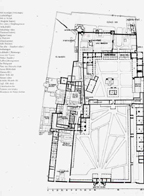
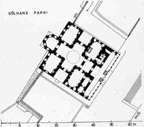
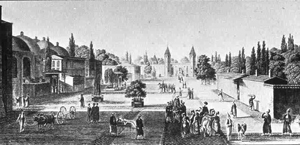
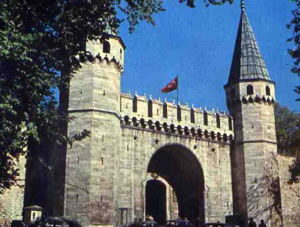 Middle Gate leading to the second court, Bab-i-Humanyun
Middle Gate leading to the second court, Bab-i-Humanyun 